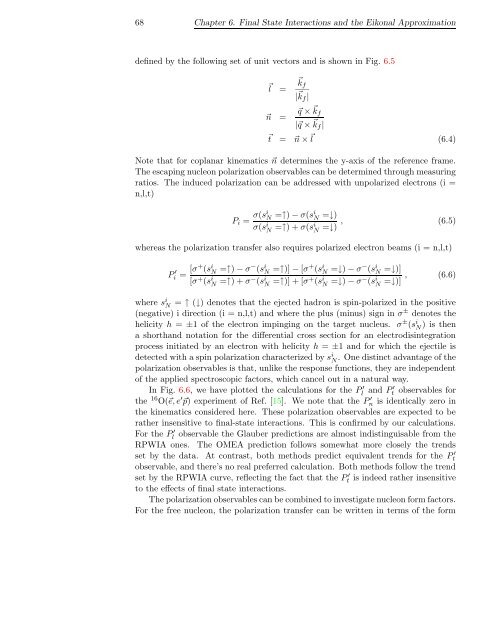Download Thesis in Pdf Format - Theoretical Nuclear Physics and ...
Download Thesis in Pdf Format - Theoretical Nuclear Physics and ...
Download Thesis in Pdf Format - Theoretical Nuclear Physics and ...
You also want an ePaper? Increase the reach of your titles
YUMPU automatically turns print PDFs into web optimized ePapers that Google loves.
68 Chapter 6. F<strong>in</strong>al State Interactions <strong>and</strong> the Eikonal Approximation<br />
def<strong>in</strong>ed by the follow<strong>in</strong>g set of unit vectors <strong>and</strong> is shown <strong>in</strong> Fig. 6.5<br />
⃗ l =<br />
⃗ kf<br />
| ⃗ k f |<br />
⃗n = ⃗q × ⃗ k f<br />
|⃗q × ⃗ k f |<br />
⃗t = ⃗n × ⃗ l (6.4)<br />
Note that for coplanar k<strong>in</strong>ematics ⃗n determ<strong>in</strong>es the y-axis of the reference frame.<br />
The escap<strong>in</strong>g nucleon polarization observables can be determ<strong>in</strong>ed through measur<strong>in</strong>g<br />
ratios. The <strong>in</strong>duced polarization can be addressed with unpolarized electrons (i =<br />
n,l,t)<br />
P i = σ(si N =↑) − σ(si N =↓)<br />
σ(s i N =↑) + , (6.5)<br />
σ(si N<br />
=↓)<br />
whereas the polarization transfer also requires polarized electron beams (i = n,l,t)<br />
P ′<br />
i = [σ+ (s i N =↑) − σ− (s i N =↑)] − [σ+ (s i N =↓) − σ− (s i N =↓)]<br />
[σ + (s i N =↑) + σ− (s i N =↑)] + [σ+ (s i N =↓) − σ− (s i , (6.6)<br />
N<br />
=↓)]<br />
where s i N = ↑ (↓) denotes that the ejected hadron is sp<strong>in</strong>-polarized <strong>in</strong> the positive<br />
(negative) i direction (i = n,l,t) <strong>and</strong> where the plus (m<strong>in</strong>us) sign <strong>in</strong> σ ± denotes the<br />
helicity h = ±1 of the electron imp<strong>in</strong>g<strong>in</strong>g on the target nucleus. σ ± (s i N ) is then<br />
a shorth<strong>and</strong> notation for the differential cross section for an electrodis<strong>in</strong>tegration<br />
process <strong>in</strong>itiated by an electron with helicity h = ±1 <strong>and</strong> for which the ejectile is<br />
detected with a sp<strong>in</strong> polarization characterized by s i N . One dist<strong>in</strong>ct advantage of the<br />
polarization observables is that, unlike the response functions, they are <strong>in</strong>dependent<br />
of the applied spectroscopic factors, which cancel out <strong>in</strong> a natural way.<br />
In Fig. 6.6, we have plotted the calculations for the P l<br />
′ <strong>and</strong> P t ′ observables for<br />
the 16 O(⃗e, e ′ ⃗p) experiment of Ref. [15]. We note that the P n ′ is identically zero <strong>in</strong><br />
the k<strong>in</strong>ematics considered here. These polarization observables are expected to be<br />
rather <strong>in</strong>sensitive to f<strong>in</strong>al-state <strong>in</strong>teractions. This is confirmed by our calculations.<br />
For the P l ′ observable the Glauber predictions are almost <strong>in</strong>dist<strong>in</strong>guisable from the<br />
RPWIA ones. The OMEA prediction follows somewhat more closely the trends<br />
set by the data. At contrast, both methods predict equivalent trends for the P t<br />
′<br />
observable, <strong>and</strong> there’s no real preferred calculation. Both methods follow the trend<br />
set by the RPWIA curve, reflect<strong>in</strong>g the fact that the P t ′ is <strong>in</strong>deed rather <strong>in</strong>sensitive<br />
to the effects of f<strong>in</strong>al state <strong>in</strong>teractions.<br />
The polarization observables can be comb<strong>in</strong>ed to <strong>in</strong>vestigate nucleon form factors.<br />
For the free nucleon, the polarization transfer can be written <strong>in</strong> terms of the form















